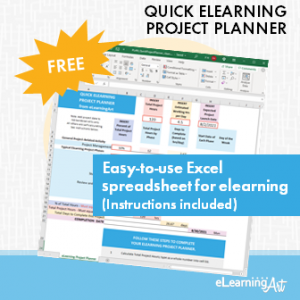Plan Your eLearning Projects
Create an eLearning Project Plan in 3 simple steps (Template and Examples Included!)
ULTIMATE GUIDE TO ELEARNING DEVELOPMENT
- Plan Your eLearning Projects
- Manage Your eLearning Projects
- Structure & Script eLearning
- Design & Prototype eLearning
- Visualize & Storyboard eLearning
- Develop & Build eLearning
- Publish & Deliver eLearning
Bonus 1: eLearning Development Calculator
Bonus 2: eLearning Best Practices Pro Tips
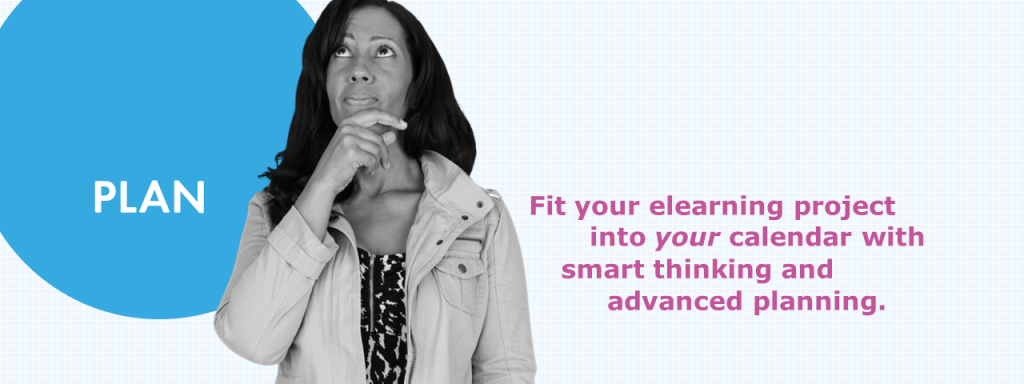
You may be surprised by how much success in elearning development comes down to smart planning and solid project management. Planning, where you think through the details of a project, match expectations and realities to a calendar, and generally visualize the flow of activities, a key part of the project. It’s both necessary and, happily, not too painful. We suggest that you get started by thinking through the five topics we offer here, then take a read through the next section of this guide about eLearning eLearning project management. With those two tasks done, you’ll be well on your way to “Wow!!”
Get our free eLearning project plan template today!
Plan out your project with development time estimates by phase.
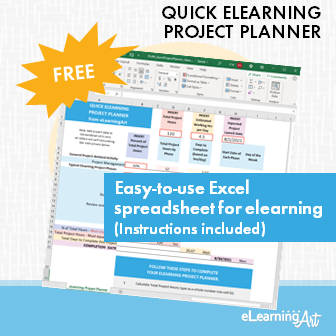
Basics of eLearning Planning
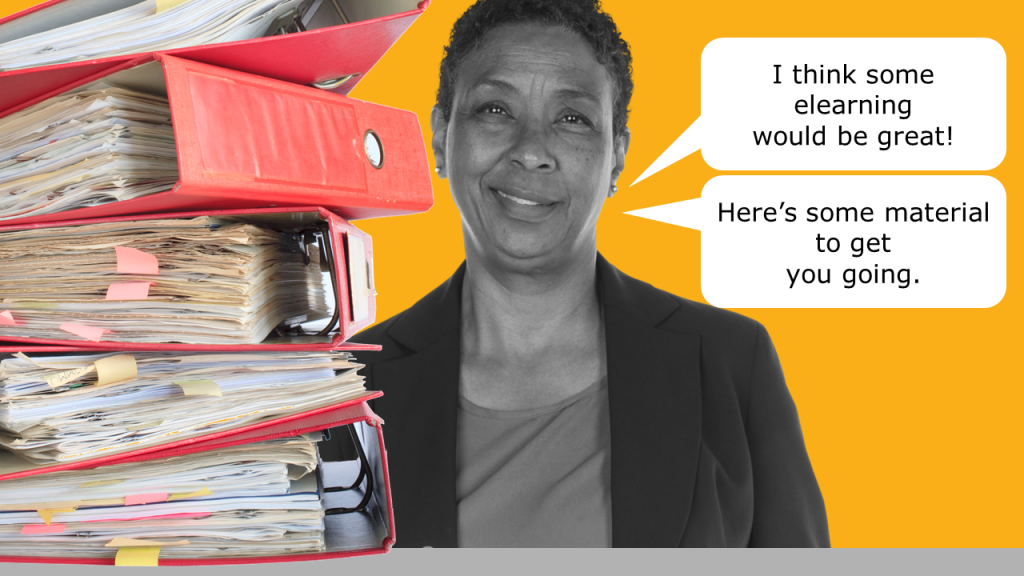
The first stage of any significant project brings with it a lot of unknowns. In fact, even for very experienced elearning people, the beginning of a project is more about not knowing than it is about knowing. It’s perfectly normal to be a little vague on the project scope, nervous about working with stakeholders, and wondering if we’ll ever “get” the topic that’s being presented. In short, if you’re feeling a little overwhelmed, that’s OK.
In the following sections we’ll address the big unknowns that you may find daunting — we know we sure did when we were just starting out! We’ll spell out the details and remove some mystery. Don’t you feel better already?
How to Plan an eLearning Course Project

Well, good news: Everyone starts right where you are, and even the people who build all day every day run into moments when they ask the same question. For planning purposes, if you’re new to any aspect of the project — the authoring tool, the subject matter, the people involved, any of it — you will want to build extra time into your project plan for moving up the learning curve.
It’s not that developing an elearning program is especially difficult. It’s just that there are a lot of aspects to the project, and you’re likely to find some that challenge you. As adults, we don’t necessarily think in terms of needing to learn things to be competent — we’re adults after all! That’s a good idea to let go of right now, before you get much further in your project, because an open mind (and sense of humor) will help you complete the project with pride.
Estimate eLearning Development Time
OK, letting you in on a little secret here: Building learning does take time. That is why any form of procrastination is a baaad idea.
Here’s a key: To ballpark the time needed, what’s helpful to know is how long, in minutes, the end-product of your work effort will be. This is referred to as “run time,” or roughly how long it will take a viewer to complete the program (note that this does not include the time it takes to complete interactions such as a quiz; that’s difficult to estimate, so usually not included in discussions of run time).
For example, maybe you’re developing a 20-minute presentation, or a 10-minute eLearning program. Often, your stakeholders will state how long they expect the program to be, but if you don’t have an idea about the time, take a good guess and confirm it by asking others involved with the project to do the same. An “educated guess” is fine.
Next, multiply the minutes you’ve come up with by a factor between 22 and 240.
Your project will fall somewhere on a spectrum from simple to complex, so adjust the factor you use in the calculation with that in mind. The higher the factor, the more development time. For example:
- Use a factor number at the low end of the range for something like a simple click-and-read PowerPoint with limited graphics.
- Use a factor at the high end for a full, interactive eLearning program that you’re starting from scratch.
Now multiply the factor times the runtime and the result is an estimate of minutes of development time. Then, for the total number of hours, divide your result by 60.
Now you have a guesstimate, in hours, of the time you’ll need to develop your project.
If all that math makes your head hurt, use our handy calculator!
Get Started with Your eLearning Project Timeline

Now that you have a total number of hours estimated to use as a guide, begin by loosely figuring out how you can schedule the hours needed to get your project launched, push it forward, and get it done.
Do this by taking a look at your calendar and workload between now and the proposed deadline. Match the total project hours to your or your team’s availability, accounting for pre-existing commitments such as regular work tasks, other projects currently in motion (or expected to be), vacations, and other availability-impacting factors.
Now, based on your quick calculations, does the deadline seem doable? Can you deliver what’s hoped for by the wished-for date, or will something need to be adjusted? That “something” might be any (or all) of the following:
- Extend the deadline to a more realistic date.
- Reduce the scope of the project to allow fewer hours to be spent on it. (For example, the program could be shorter, or it could be simpler. Fiddle with the development calculator to test scenarios.)
- Take the project in phases, delivering a simpler solution sooner that will serve as the foundation for a more time-consuming solution later.
- Add people to the project. (But note that this solution should be applied with caution! The bigger the team, the more time you must take to manage it. Time is what you’re short on, right?)
If you’ve traveled this far in your project, congratulations!! You’ve started your project. No more worries there.
10 eLearning Project Phases and Milestones
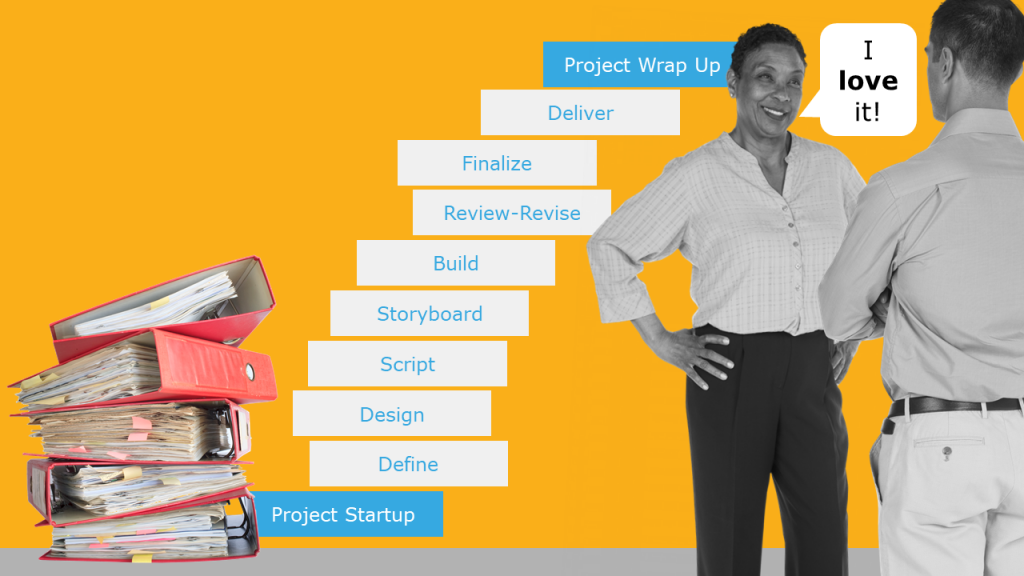
Let’s start toward a project plan by understanding that elearning projects have a logical flow that carries the builder from a messy pile of content to beautiful and engaging elearning. This runs roughly as follows:
Project Startup — Often chaotic and confusing, during this phase the content to be included (or not) begins to be defined (that would be the “scope” of the project) and the order of presentation begins to take shape (and that’s the “sequence”). These aren’t locked down by any means, but you’ll start to get a sense of the project, and, as an added bonus, the people involved.
Project Definition — Here a tighter lock is put on scope and sequence, source material is sorted and captured, people’s roles are defined, and the project, generally, begins to take shape.
Project Design — Not always included, but often useful, is a quick round in which the proposed look and feel of the project is put in front of decision makers. This is often referred to as “prototyping,” and should be polished enough to get the ideas across, but need not be perfect.
Project Scripting — Like movies, videos, and TV commercials, elearning is a script-driven product, so this phase is one of the most important! Here you work out how the content is presented both in terms of audio (voice over) and on-screen text, and think through things like the program framework and flow.
Project Storyboarding — Another activity that’s not always executed, but can be useful. A storyboard pre-builds the slides, matching the script to graphics and providing details on the building process.
Project Build — This is it! Planning, script, graphics, everything comes together in the build phase. Typically for elearning, building will happen in an authoring tool, such as Articulate Storyline, Adobe Captivate, or similar, but this phase is important in instructor-led presentations, too.
Project Review and Revisions — Often blended into the building phase, project reviews allow stakeholders and subject matter experts to look at the project pre-completion in order to suggest any needed revisions. (Note that in many projects, this phase must be managed carefully to avoid seemingly endless rounds of changes. Manage expectations carefully from the get-go about the importance of thorough but limited review cycles.)
Project Finalizing — Almost done now! During this phase, the final steps are completed toward project completion. These can include a final review cycle, an internal quality assurance review (with any required revisions), SCORM publishing and testing, and other get-it-done-right steps. (Caution! This phase often lives up to the aphorism, “He who has a hundred miles to walk should reckon ninety as half the journey.” The final steps can take much longer than anyone, most especially you, think they should, and this applies doubly to projects with more than a single elearning module.)
Project Delivery — A great day indeed! Here, you’ll finish up the final packaging, gather elements that need to be passed back to the client, and get the whole project delivered. Celebrate!!
Project Wrap Up — Complete any tasks needed to leave the project in tidy shape for next time. Likely as not, your project will leave behind a trail of graphics, audio files, scripts, drafts, notes, and who knows what else. Before too much time goes by, get organized (and, if possible, get it off your hard drive — you’ll need the space for your next project).
And that’s it!
Create an eLearning Project Plan
A project plan is a beautiful thing, but before you spend too much time creating one, it’s important to note that plans are born to be broken! So, please take it from the voice of experience: Limit the time you spend on drafting a plan and keep it high level. We’ll show you a quick trick that will help you get something together quickly now.
To build a plan with estimated hours by phases, do the following:
- Figure out which of the phases given above will be part of the project you’re planning right now, and,
- Guesstimate the percentage of total project time that will be taken up in each phase. (These percentages should add up to 100%, but if this is a big project or you’re very new to this kind of project, immediately set aside 10% of the total hours for project management and learning. Then, the remainder of the phases should be calculated to add up to 90% of the total hours.)
- Apply your percentages to the calculation of total hours, and you’ll know how long you have for each phase.
If you want, you can add dates to match the hours for a big, beautiful project plan (subject to change, of course!).
In Conclusion
Even though it happens early in the game, the work you do in regard to project planning can help you get the project done. Soon enough, you’ll be stepping back and appreciating your completed program.
Now jump over to the next chapter of the guide and get started with some great eLearning project management templates and tips
Frequently Asked Questions on Planning
In general, an elearning project focuses on development of a learning-related program that will be delivered through a learning management system (LMS) or other online method. The specifics of elearning projects vary widely, from simple “repackaging” of existing videos to “screencasts” of steps and processes that happen on a computer to full builds of highly-sophisticated full-branching programs … and everything in between!
A general sequence of activities that lead to completing the program creation process is given by the acronym ADDIE. Begin by Analyzing the learning that must take place and matching content to those objectives. Next, Design the program both graphically and in terms of sequencing, scriptwriting, and, optionally, storyboarding. Complete the Development phase next, using an elearning authoring tool, screencasting program, PowerPoint, or other method. Implement the program, making it available to learners. And finally, Evaluate the program in terms of its effectiveness in delivering the expected learning outcomes. ADDIE should be considered an iterative process, so setting an early expectation for reviews and revisions will help ensure that you create the best online training program possible.
We hate to be cliche, but the correct answer here is, “it depends.”. Because the specifics of elearning projects vary so widely, it’s best to really understand the scope of a given project before committing to time allocations. Take a look at our time calculator here to get a sense of what goes into projecting the hours required to complete a project.
Yes, you can create simple elearning even on a tight budget. For example, if you just wish to deliver your content online, you can create an attractive slide deck in PowerPoint, then publish it directly from PowerPoint as a shareable video. Sometimes having a tight budget means thinking outside the box and we’ve heard of projects that successfully deliver learning via email, PDF, and virtual meetings.
Time and cost are very much related when it comes to creating elearning, so the strategies you can use for low-budget projects are also applicable to time-strapped projects. Your goal in producing elearning of any sort is to deliver the learning content in an attractive and orderly format, so your audience can lock in on what’s important. Even in a quickly executed project, it’s time well-spent to use some of your project time to think through how you’ll achieve these goals.
As a field, elearning evolves along with technology. Terms like these reflect the new approaches that arise. “mLearning,” for example, refers to the delivery of learning content on mobile devices such as tablets and smartphones. In a similar way, the term “eLearning” is thought to be a shortening of the phrase “electronic learning,” and largely replaced the “computer-based training” or “CBT” that came before it. These are all ways of referring to learning that’s delivered in a computer-mediated environment, of course. “Blended learning” extends this to include both digital delivery methods and analog methods. For example, the basic content of a blended learning course may be offered as elearning but extended into the learner’s environment with a printed guide, work aid, or assignment.
The final length of an elearning project is determined by the quantity of information included in the program, the runtime of any videos that are included, and, when present, the speed at which the voice over audio is spoken. Usually, it’s an estimate of how long the program takes if it were to be viewed straight through — the actual time a person spends viewing and interacting with the program may be longer or shorter. In general, a limit of about 20 minutes of runtime per elearning module is recommended. Targeting a program of this length (or less) means both reduced demand on learner attention spans and a reasonable file size for development, stakeholder review, and quality control activities. [note: if you have an input like a voice over script, a instructor led presentation deck, etc, check out our conversion calculator here]
Instructional design focuses on how to present content so that it will be actionable, memorable, and useful to the audience viewing an elearning program. An elearning program informed by strong instructional design will begin with well-defined learning objectives that are derived from real-life assessments of actual tasks and how they are successfully performed. From there, program delivery is designed to conform to researched, evidenced-based understandings about adult learning to help ensure that the expected transfer of knowledge from program to viewer can and does occur.
Because instructional design focuses on making sure learning can happen, it’s a critical factor in delivering on the real purpose of an elearning program: learning. Although it may appear to be a luxury, good instructional design sees to it that program-related costs — the time, money, and attention resources required to develop, deliver, and participate in the program — are balanced by actually achieving the desired learning objectives.


